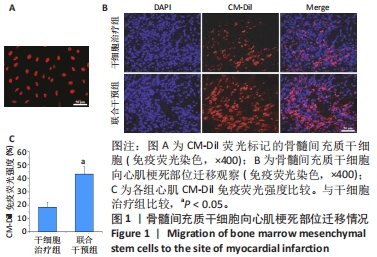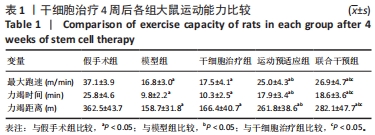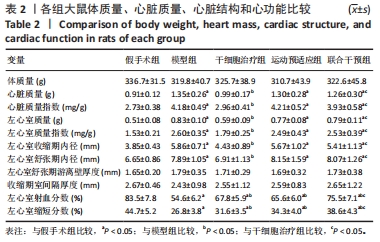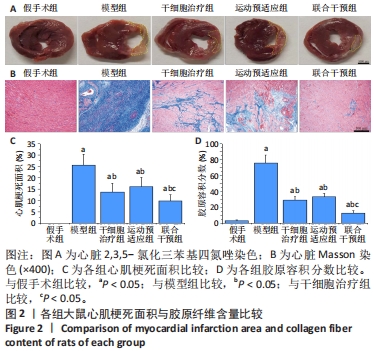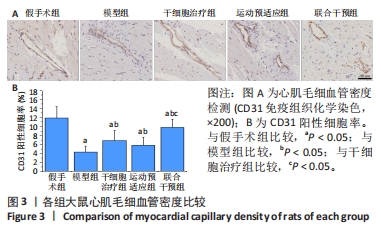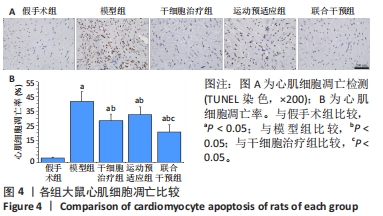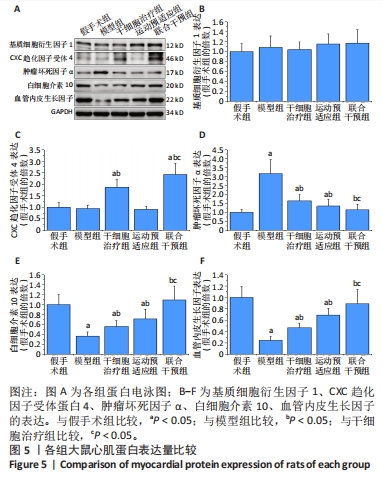[1] DAUERMAN HL, IBANEZ B. The Edge of Time in Acute Myocardial Infarction. J Am Coll Cardiol. 2021;77(15):1871-1874.
[2] SAITO Y, OYAMA K, TSUJITA K, et al. Treatment strategies of acute myocardial infarction: updates on revascularization, pharmacological therapy, and beyond. J Cardiol. 2023;81(2):168-178.
[3] FRANTZ S, HUNDERTMARK MJ, SCHULZ-MENGER J, et al. Left ventricular remodelling post-myocardial infarction: pathophysiology, imaging, and novel therapies. Eur Heart J. 2022;43(27):2549-2561.
[4] 孙维兴,赵永超,赵然尊.间充质干细胞移植治疗心肌梗死:问题、症结及新突破[J].中国组织工程研究,2021,25(19):3103-3109.
[5] YAMADA Y, MINATOGUCHI S, KANAMORI H, et al. Stem cell therapy for acute myocardial infarction - focusing on the comparison between muse cells and mesenchymal stem cells. J Cardiol. 2022;80(1):80-87.
[6] 陈天然,潘珊珊.运动预适应:心脏康复预防与治疗的新策略[J].上海体育学院学报,2021,45(10):72-80.
[7] SCHAUN MI, MOTTA LL, TEIXEIRA R, et al. Preventive physical training partially preserves heart function and improves cardiac antioxidant responses in rats after myocardial infarction preventive physical training and myocardial infarction in rats. Int J Sport Nutr Exerc Metab. 2017;27(3):197-203.
[8] 杨斌宾,詹蔷,邹密,等. 运动促进青春期小鼠造血干细胞造血重建功能[J].中国病理生理杂志,2022,38(6):1056-1062.
[9] 范朋琦,秦永生,彭朋.不同运动方式对自发性高血压大鼠心脏重塑和运动能力的影响[J].现代预防医学,2018,45(23):4341-4345.
[10] 孟宪欣,管泽毅,葛吉生,等.间歇运动干预自发性高血压大鼠病理性心脏肥大:运动强度与健康效应的关系[J].体育科学,2019,39(6):73-82.
[11] 李朝中,肖践明,陈丽星,等.大鼠骨髓间充质干细胞体外分离培养与cm-dii荧光标记[J].中国组织工程研究,2014,18(1):39-44.
[12] DE FREITAS JS, NEVES CA, DEL CARLO RJ, et al. Effects of exercise training and stem cell therapy on the left ventricle of infarcted rats. Rev Port Cardiol (Engl Ed). 2019; 38(9):649-656.
[13] HUANG P, WANG L, LI Q, et al. Atorvastatin enhances the therapeutic efficacy of mesenchymal stem cells-derived exosomes in acute myocardial infarction via up-regulating long non-coding RNA h19. Cardiovasc Res. 2020;116(2):353-367.
[14] JENČA D, MELENOVSKÝ V, STEHLIK J, et al. Heart failure after myocardial infarction: incidence and predictors. ESC Heart Fail. 2021;8(1):222-237.
[15] TAN Y, WANG L, CHEN G, et al. Hyaluronate supports hesc-cardiomyocyte cell therapy for cardiac regeneration after acute myocardial infarction. Cell Prolif. 2020;53(12): e12942.
[16] XUAN L, FU D, ZHEN D, et al. Extracellular vesicles derived from human bone marrow mesenchymal stem cells protect rats against acute myocardial infarction-induced heart failure. Cell Tissue Res. 2022;389(1):23-40.
[17] SHARMA AK, KUMAR A, SAHU M, et al. Exercise preconditioning and low dose copper nanoparticles exhibits cardioprotection through targeting gsk-3β phosphorylation in ischemia/reperfusion induced myocardial infarction. Microvasc Res. 2018;120:59-66.
[18] HAFEZ S, KHAN MB, AWAD ME, et al. Short-term acute exercise preconditioning reduces neurovascular injury after stroke through induced eNOS activation. Transl Stroke Res. 2020;11(4):851-860.
[19] 朱政,付常喜,马文超,等.有氧运动调控自发性高血压模型大鼠心脏重塑的机制[J].中国组织工程研究,2022,26(14):2231-2237.
[20] 施曼莉,李晓霞.有氧运动对慢性心力衰竭大鼠病理性心脏肥大的影响[J].体育学刊,2015,22(3):127-134.
[21] ZHUANG C, LUO X, WANG Q, et al. The effect of exercise training and physiotherapy on diastolic function, exercise capacity and quality of life in patients with heart failure with preserved ejection fraction: a systematic review and meta-analysis. Kardiol Pol. 2021;79(10):1107-1115.
[22] CAMERA DM, SMILES WJ, HAWLEY JA. Exercise-induced skeletal muscle signaling pathways and human athletic performance. Free Radic Biol Med. 2016;98:131-143.
[23] FIUZA-LUCES C, SANTOS-LOZANO A, JOYNER M, et al. Exercise benefits in cardiovascular disease: beyond attenuation of traditional risk factors. Nat Rev Cardiol. 2018;15(12):731-743.
[24] ONG SB, HERNÁNDEZ-RESÉNDIZ S, CRESPO-AVILAN GE, et al. Inflammation following acute myocardial infarction: multiple players, dynamic roles, and novel therapeutic opportunities. Pharmacol Ther. 2018;186:73-87.
[25] 何灵娟,周斌.心肌干细胞与心脏再生的研究进展及展望[J].中国科学:生命科学,2021,51(1):12-25.
[26] 刘远志,周吉银,黄毅岚,等.促进间充质干细胞归巢的研究进展及其相关机制[J].生理科学进展,2018,49(3):237-241.
[27] UNZEK S, ZHANG M, MAL N, et al. Sdf-1 recruits cardiac stem cell-like cells that depolarize in vivo. Cell Transplant. 2007;16(9):879-886.
[28] GATTI M, PATTAROZZI A, BAJETTO A, et al. Inhibition of cxcl12/cxcr4 autocrine/paracrine loop reduces viability of human glioblastoma stem-like cells affecting self-renewal activity. Toxicology. 2013;314(2-3):209-220.
[29] DONG F, HARVEY J, FINAN A, et al. Myocardial cxcr4 expression is required for mesenchymal stem cell mediated repair following acute myocardial infarction. Circulation. 2012;126(3):314-324.
[30] WANG M, HU R, YANG Y, et al. In vivo ultrasound molecular imaging of sdf-1 expression in a swine model of acute myocardial infarction. Front Pharmacol. 2019;10:e899.
[31] KWON SG, PARK I, KWON YW, et al. Role of stem cell mobilization in the treatment of ischemic diseases. Arch Pharm Res. 2019;42(3):224-231.
[32] UEMATSU M, YOSHIZAKI T, SHIMIZU T, et al. Sustained myocardial production of stromal cell-derived factor-1α was associated with left ventricular adverse remodeling in patients with myocardial infarction. Am J Physiol Heart Circ Physiol. 2015;309(10):H1764-H1771.
[33] SARTO P, BALDUCCI E, BALCONI G, et al. Effects of exercise training on endothelial progenitor cells in patients with chronic heart failure. J Card Fail. 2007;13(9):701-708.
[34] XIA WH, LI J, SU C, et al. Physical exercise attenuates age-associated reduction in endothelium-reparative capacity of endothelial progenitor cells by increasing cxcr4/jak-2 signaling in healthy men. Aging Cell. 2012;11(1):111-119.
[35] THACKERAY JT, HUPE HC, WANG Y, et al. Myocardial inflammation predicts remodeling and neuroinflammation after myocardial infarction. J Am Coll Cardiol. 2018;71(3):263-275.
[36] SHIRAKAWA K, ENDO J, KATAOKA M, et al. IL (interleukin)-10-stat3-galectin-3 axis is essential for osteopontin-producing reparative macrophage polarization after myocardial infarction. Circulation. 2018;138(18):2021-2035.
[37] TAO Z, TAN S, CHEN W, et al. Stem cell homing: a potential therapeutic strategy unproven for treatment of myocardial injury. J Cardiovasc Transl Res. 2018;11(5): 403-411.
[38] PEDERSEN BK. Anti-inflammatory effects of exercise: role in diabetes and cardiovascular disease. Eur J Clin Invest. 2017;47(8):600-611.
[39] CHUNG C. From oxygen sensing to angiogenesis: targeting the hypoxia signaling pathway in metastatic kidney cancer. Am J Health Syst Pharm. 2020;77(24):2064-2073.
[40] LI T, ZHANG T. The application of nanomaterials in angiogenesis. Curr Stem Cell Res Ther. 2021;16(1):74-82.
|

